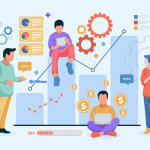A contact center is a centralized office that provides customer support through various channels such as phone, email, web, and chat. A call center is a type of contact center that deals primarily with phone calls. The main difference between a contact center and a call center is the type of channels that each one uses to provide customer support.
What is a contact center?
A contact center is a customer service center that provides support to customers through various channels such as phone, email, and chat. It is usually the first point of contact for customers and is responsible for handling customer inquiries and complaints.
Contact centers typically offer a wide range of advantages, including 24/7/365 availability, multilingual support, scalability, and cost savings. Additionally, contact centers can help businesses to improve customer satisfaction and loyalty while also providing valuable data and insights.
A contact center is highly efficient because contact centers can route customers to the most appropriate agent based on the channel that they are using, their location, and the type of inquiry. It leads to shorter wait times and more satisfied customers.
What is a call center?
A call center is a customer service center that provides customer support through telephone calls. Call centers typically use a variety of customer service tools and systems to handle customer inquiries, including customer relationship management (CRM) software, interactive voice response (IVR) systems, and automatic call distributors (ACDs). Call center agents use these tools and systems to log customer calls, track customer interactions, and provide customer support.
Contact center vs. call center: What are the differences?
It’s all about the channels used to support and serve their customers. A contact center has a wide range of channels that customers can use to contact them, including phone, email, social media, and web chat. You could say that a contact center is the nerve center of the company, handling all inbound and outbound customer interactions across all channels. A call center usually focuses on phone calls – inbound and outbound. Call centers are often equipped with automatic call distributors (ACDs), which route calls to the next available representative.
While a call center is a subset of the contact center, there are some key differences between the two. The most obvious difference is the focus on phone calls, but there are also differences in the technology used, the training of representatives, and the types of interactions handled. We will look at a few of these differences in this article.
Predictive support
Contact centers have the advantage of multiple channels of communication from where the data can be aggregated for predictive analytics. They can have deeper insights into customers and offer more varied support. The data also ensures higher performance and lower customer churn. Contact centers provide both proactive and reactive support. The digital space gives contact centers an edge because the voluminous data gives them the history and enables predictive support based on past trends in customer interaction. Call centers are limited in their predictive efforts because using phone calls only gives them a piece of the puzzle.
Different uses
Today’s customers prefer everything digital and contact centers that offer multiple platforms. A call center relies on phone calls to communicate with its customers. They provide technical support and can be helpful in telemarketing and lead generation. Call centers are more traditional and suited for specific industries that prefer phone communication.
Technology adoption
A contact center uses advanced technology and automation to route service tickets to appropriate agents. A cloud-based contact center software ensures that calls are routed to specific agents based on their skill, customer history, and preferred channel to reduce resolution time. In contrast, a call center uses software tools with automatic call distribution to route the calls to a specific agent. Despite being phone-based, technology is more efficient but limited to inbound and outbound calls.
Staffing dependence
Contact centers don’t need scaling up because the agents can handle more than one customer at a time and leverage the different channels available. They can deliver without compromising customer experience and can be a lean team. Call centers are more dependent on their workforce because of the agent’s bandwidth. They either have to increase staffing during peak volumes or outsource a portion of the workload, adding to operational costs.
Self-service functionality
A self-service contact center allows customers to serve themselves through an automated system, such as an interactive voice response (IVR) system or a web-based self-service portal. It can be a much more cost-effective solution for businesses, as they can route calls to self-service options when possible and only use live agents when absolutely necessary. Additionally, self-service contact centers can provide a better customer experience, as customers can get the answers they need without being out on hold to wait for a live agent. A call center only provides self-service options for tasks such as account management and task tracking. While call centers also offer service through IVR, the wait time for ticket resolution tends to take long.

Customer satisfaction
Studies show that customers prefer doing business with companies that offer multiple ways of communication. Today’s customers prefer digital-first service and don’t want to experience the limitation of using only a call center. Contact centers provide omnichannel service with a seamless customer experience as they move from channel to channel.
Automation in workflow management
Contact center automation covers ticket creation, routing, updating tickets, and follow-ups with automated alerts to close the loop. Agents working in contact centers also use automation to reduce the routine, repetitive tasks giving them time to build a more meaningful interaction with their customers. On the other hand, call centers use automation for inbound and outbound calls, offer personalized voicemails, redirect the after-hours calls, etc., and nothing more.
Unified and integrated view of customer interactions
Contact centers provide a 360-degree view of their customers with data collected from multiple channels. The centralized view can be integrated with other software, such as CRM, to get a comprehensive customer view on a single platform. Call centers have only the phone channel to collect whatever data they can, leaving customer experience a little short on overall satisfaction.
The above differences may be enough to choose between a contact center and a call center to serve your customers better. We live in a customer-centric digital era. Customers seeking immediate answers and instant gratification have no time for long queues and long wait times. Good customer service is what keeps businesses still standing in a competitive market. Giving customers more ways to reach you, using a proactive approach to anticipating customer needs, and engaging in a meaningful rather than transactional relationship are three key aspects employed by a contact center. Businesses focusing on these three aspects know the value of superior customer experience.
While call centers do serve a purpose, they fall a little short because reaching an agent is not always quick. Taking a number and waiting in the queue is akin to physical queues and can be frustrating. Moreover, the customers get routed from one agent to another or a team before they find the resolution they need.
Different types of call centers
Before deciding on which form of customer service to take, you may want to understand the different types of call centers – Inbound, outbound, and automated call centers.
What is an inbound call center?
By definition, an inbound call center handles incoming calls from customers. The interaction involves initial customer queries, and the agents answering these calls are trained to provide quick and short answers. An inbound call center works very well for those businesses that deal with technical support, such as internet service providers, distributors, etc. The same is true of billing-related support, where you can get information on your account or billing errors if any.
What is an outbound call center?
Agents working in the outbound call center make calls more than receive them. These agents use customer data and call them to promote or sell products and services. Another use of outbound call centers is to engage in market research or surveys to collect data, which can then be used for more outbound calls to sell a service. However, they could also cover regular reminders for when payments are due or to announce a policy change.
What is an automated call center?
Automated call centers have an edge as they can handle inbound and outbound calls. They use technology to automate call routing and extend calling to other channels such as emails, text messages, etc. Automated call centers offer remote working and uninterrupted service regardless of the location and can work with other digital systems.
Final words
Whether your business needs a contact center or a call center depends on the company’s needs. Other factors to consider would include your company’s specific goals, budget, etc. Establishing either can’t be a quick decision as there are pros and cons to consider. However, future-proofing your business plays a significant role in the selection process. You would need a scalable solution to keep pace with your business growth. And it is a given that superior customer experience leads to the desired growth.
Therefore, if customer satisfaction is the primary goal, then a contact center is likely the better choice, even if it means more upfront cost.






















